The Telescope in the Ice: The Hunt for the Ghost Particle
Air Date: Week of February 23, 2018

The aurora australis or Southern Lights produce different colors based on where electrons that enter our atmosphere encounter atoms of oxygen and nitrogen. Both the type of atom and the altitude affect the color that we see. Here a colorful aurora swirls above the IceCube Lab. (Photo: Keith Vanderlinde, NSF)
One of the world’s most sensitive telescopes is buried deep in Antarctic ice, searching for evidence of elusive neutrinos, tiny, subatomic particles. Writer Mark Bowen’s new book, The Telescope in the Ice: Inventing a New Astronomy at the South Pole, chronicles the decades-long project to build the IceCube Neutrino Observatory. As he tells Living on Earth host Steve Curwood, IceCube’s ability to spot where neutrinos came from provides a powerful new tool for understanding many mysteries of the universe.
Transcript
KAISER: It’s Living on Earth, I’m Jaime Kaiser.
DOERING: And I’m Jenni Doering, we’re in for Steve Curwood. Ever since Galileo turned his telescope towards the heavens four centuries ago, these finely tuned instruments have produced breathtaking images – of planets, and other galaxies.
KAISER: But one of the most exciting new telescopes doesn’t “look” at anything at all, in the traditional sense. The IceCube Neutrino Observatory is made up of thousands of light detectors, buried in a cubic kilometer of diamond-clear ice at the South Pole.
DOERING: It’s searching for neutrinos – tiny, almost massless subatomic particles that can pass through a light-year of lead without slowing down, and perhaps they can even shed light on how our universe formed after the Big Bang 13.8 billion years ago.
KAISER: The telescope’s creation story is also an epic tale that writer Mark Bowen captures in his book The Telescope in the Ice. He spoke with Living on Earth host Steve Curwood.
CURWOOD: So, IceCube is designed to detect neutrinos, sometimes called ghost particles. So, in layman's terms, what exactly is a neutrino?
BOWEN: It is an elementary particle, that means I don't think it can be broken up into anything else. It's a very basic constituent of matter and it's really odd and very hard to detect. It was, interestingly, one of the first elementary particles to be discovered. The only ones that were known in 1930 when Wolfgang Pauli had this incredible feat of kind of insight and intuition were the proton, the photon, and the electron. And the strange thing about the neutrino is that even now nobody understands it very well, and it's one of the forefronts of particle physics because it just is this really weird particle.
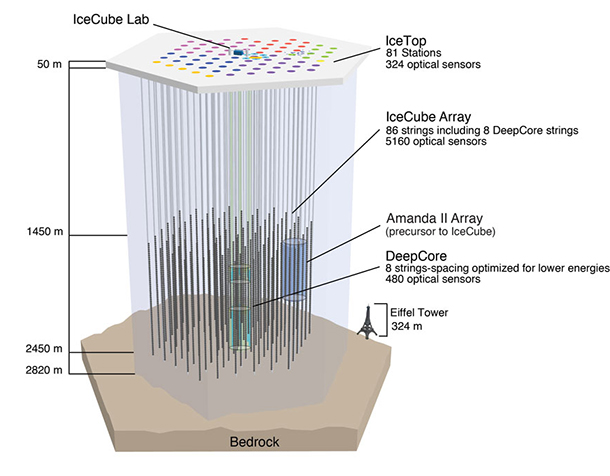
The IceCube Neutrino Observatory instruments a volume of roughly one cubic kilometer of clear Antarctic ice with 5,160 digital optical modules (DOMs) at depths between 1450 and 2450 meters. The observatory includes a densely instrumented subdetector, DeepCore, and a surface air shower array, IceTop. (Image: IceCube Collaboration)
CURWOOD: Why is science so fascinated with the neutrino? What is it that we're trying to understand, do you think?
BOWEN: For two reasons, first of all, it will help explore the universe, explain the behavior of these incredibly strange things that are being discovered far off in outer space. We have now entered this era called multi-messenger astronomy. We saw this merging neutron star event which resulted in a gravitational wave, and it was also seen with light. The neutrino would be yet a third messenger besides light and gravitational waves with which we can look at these exotic things like merging neutron stars or blazars, these incredibly bright galaxies off in the cosmos and things of that sort.
So, it's an astrophysical tool, and the neutrino has so far revealed the only physics beyond the standard model of particle physics. So, back in the 1970s, people like Steven Weinberg, Sheldon Glashow, Abdus Salam, put together something called the standard model which explains by now all the known elementary particles.
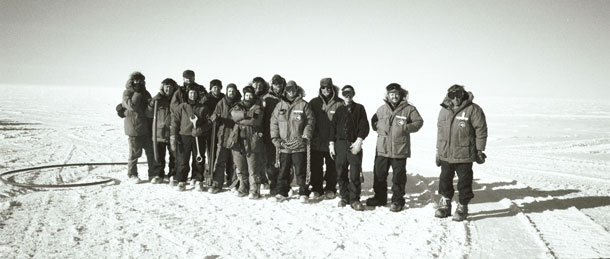
Members of the AMANDA (Antarctic Muon And Neutrino Detector Array) drilling crew in the millennial season of 1999-2000. “Master driller” Bruce Koci stands at the far right. (Photo: Mark Bowen, AMANDA/NSF)
The last one that was discovered was the Higgs boson to great fanfare in 2012. Well, it's getting a little bit scary now because the standard model works so well that it's beginning to feel like a straitjacket. It seems like people have discovered everything they can -- that they can discover and scientists don't like that. They like to discover new things, but the neutrino has actually revealed some physics beyond the standard model. The standard model says that it should not weigh anything and an experiment very much like IceCube showed in 1997 that neutrinos have mass. So, right now there are probably a billion or more dollars worth of research efforts aimed at trying to explore the neutrino to see if they can uncover new physics that might lead to, oh, just new beauty in the universe really. I mean, basic science is exploration at its heart.
CURWOOD: Talk to me about the basic design of the IceCube and how on Earth it's supposed to be able to detect these tiny particles that are...they have mass, but barely apparently.

The deployment of each of the 86 IceCube strings lasted about 11 hours. In each one, 60 sensors (called Digital Optical Modules, or DOMs) had to be quickly installed before the ice completely froze around them. (Photo: IceCube/NSF)
BOWEN: The key to detecting one at least in this case is to monitor some huge volume of some clear material and watch for an interaction of the neutrino...a neutrino with that material. What happens is, when a neutrino interacts with either a proton or a neutron, something in the nucleus of any atom at all, or molecule, it disappears and knocks out a particle that gives off light that can be seen. So, you don't actually look at the neutrino itself, you look at the product of the neutrino’s demise and that particle is knocked out just like -- as if you hit a billiard ball head on with a cue ball, gets knocked out of that nucleus going in pretty much exactly the same direction as the neutrino was going in.
A neutrino can produce three kinds of particles, but the basic one, the workhorse is called a muon, which is just like an electron, but it happens to weigh more and it has some other slight differences. The muon will speed through the ice or you can use water or you can use air. It has to be clear because you have to see the light that it's giving off. It's actually going faster than light can travel in that medium. It's not breaking Einstein's postulate of special relativity that nothing can travel faster than the speed of light. It is travelling about the speed of light but light itself would go slower because that medium has an index of refraction. So, therefore, what happens is it drags a cone of light behind it because the light can't keep up with it. It's just like a boat on a lake. The reason that the waves come off in an angle behind the boat is that the waves can't go as fast as the boat, and that's exactly what's happening except it's three dimensional.
So, this thing is zooming through the ice and it's dragging this cone of -- of light behind it, and what the IceCube scientists have done is drilled deep, deep holes, a mile and a half, or a mile and three-quarters deep in the incredibly clear ice at the South Pole, and dropped into them these strings of pearls, these basketball sized light detectors, and they've created this three dimensional grid of light detectors in the ice. And since that muon is traveling in the same direction as the neutrino was, you have a telescope, you can see where the neutrino came from, you can point back and see what object might have created that neutrino.
CURWOOD: So, Mark, if you just need a clear medium, why not use water? Why not use air? Why go to the South Pole and drill a mile and a half in the ice and, you know, that's not exactly the easiest place to work, the South Pole.
BOWEN: Yes, very good question. As it turns out, amazingly, the South Pole is a very easy place to work compared to the ocean because you don't have waves, because you can walk on your experiment, because you don't have to deal with ocean engineering, and in fact, the first valiant and pioneering attempt to do this was off the coast of the big island of Hawaii. They tried for something like 14 years and failed because, largely, of the difficulties of deploying these same sorts of strings of detectors on the ocean floor, and so it turns out to be cheaper, they tried this project in Hawaii, they had been going for something like 10 years or 11 years by the time the project that is now IceCube, it was then known as AMANDA, the Antarctic Muon and Neutrino Detector Array. They began trying to deploy strings in the ice in 1991, and they actually succeeded in having a semi-working instrument by 1993, in like two or three years, whereas the Hawaiian project even after 11 years hadn’t put a string on the bottom of the ocean.
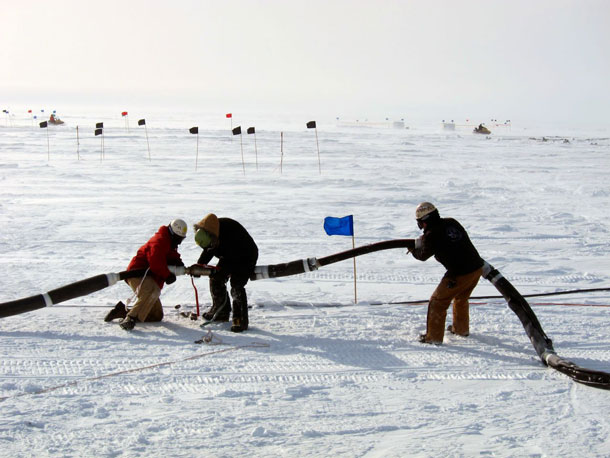
Members of the drilling crew working on the hose that carried hot water across the ice from the heating plant to the IceCube drill. (Photo: IceCube/NSF)
CURWOOD: And tell me why the atmosphere isn't a great place to try to detect these neutrinos from outer space?
BOWEN: So, both IceCube and this Hawaiian attempt which was called DUMONT, the Deep Underwater Muon and Neutrino Detector are buried like a mile deep in the water or the ice. The reason is that you use that overburden, what's above the instruments as a shield because right now, Steve, you and I have zillions of cosmic ray particles zipping through our bodies and into the Earth. IceCube is buried more than a mile deep in the ice in order to block or attempt to block those particles. Some of them still punch through all the way down a mile deep. So, the instrument is actually designed to look the other way. If you're standing on the South Pole, the instrument looks down. It's looking for muons coming up from what would be the northern sky. It is looking for neutrinos that have made it all the way through the Earth and then happen to interact with the ice right near the detector or even the bedrock below it, and set a muon zooming through the detector.
CURWOOD: So, IceCube and its predecessor AMANDA, that Antarctic Muon and Neutrino Detector Array that you described, required actually drilling holes hundreds and well thousands of meters deep into Antarctica's ice. How on Earth did the master driller and his name is Bruce Koci and his team accomplish this in such a hostile environment?
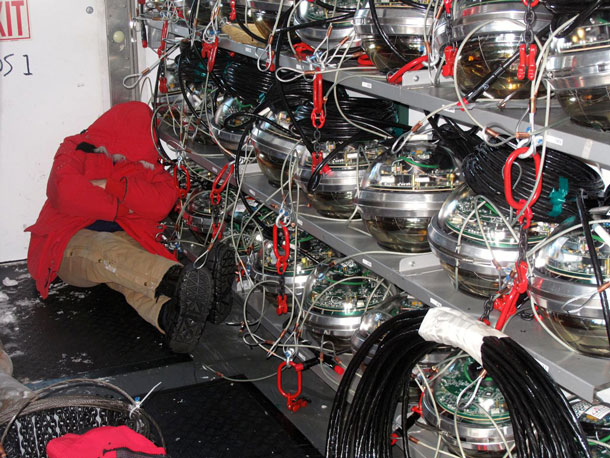
An exhausted IceCubist catches a nap in the drilling and deployment building, next to a rack of IceCube DOMs ready to be dropped into the ice. (Photo: IceCube/NSF)
BOWEN: Bruce was capable of dealing with hostile environments. [LAUGHS] I tell the story about when they first met him because they did a test hole in Greenland back in 1990 or something like that, Bruce would sleep outside it in an unheated tent on the summit of Greenland 10,000 feet high. You had this kind of intuitive almost shamanistic knowledge of ice that Bruce Koci had from decades of drilling ice cores and doing hot water drilling which is what IceCube uses, and basically they just stuck their nose into it, made a bunch of mistakes and learned as they went along. They also had to deal with whether they had enough funding and enough support, so sometimes they had to compromise on the drill just because they couldn't get enough money to build the one they really wanted to build, and you know the first drill they tried actually got stuck in the ice.
So, then they go back two years later and they have a successful drilling season, and then they slowly work themselves down deeper and deeper into the ice and the first time they got really deep into the ice I think it took 12,000 gallons of fuel and it probably took them five days or a week to drill the hole, and by the time they were drilling the 86 holes they needed to drill for IceCube, I think they could drill a hole in something like 24 hours and they used only something like 3,000 gallons worth of fuel. So, over time you just learn and you just hone it and it's a real team effort.
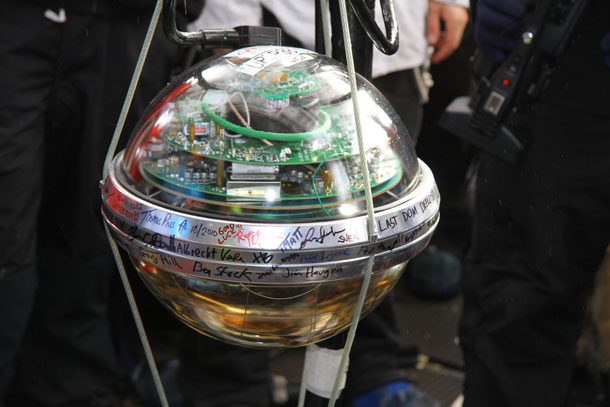
Scientists, engineers and drillers working on the deployment of IceCube in December 2010, signed the last DOM before it was buried one mile deep in the Antarctic ice. (Photo: Robert Schwarz, NSF)
CURWOOD: Talk to me about the moment that somebody actually saw one of these neutrinos from outer space, not locally produced by cosmic rays dancing around in our atmosphere. Talk to me about that moment and what that was like.
BOWEN: That was a very interesting moment. First of all, I think it happened in 2011. So, they had been working on this for 14 years at that point since it began in 1987, the experiment. And it was a Japanese woman by the name of Aya Ishihara at the University of Chiba in Japan. She had been working on IceCube for a long time, several years. So, she was looking for a very high energy kind of neutrino that comes from very high energy cosmic rays bouncing off the cosmic microwave background. They are thousands of times more energetic than any particle that could be created at the Large Hadron Collider. Of course, she was looking down into the earth. She was looking at the northern sky.
What happened was two incredibly high energy neutrinos snuck past the filters she was using to find the particles she was looking for, and they came from the southern sky. So, it was a total surprise. It was a mistake. Her filters weren't good enough, and when they looked closely at those two neutrinos, they realized that they had to be coming from outer space. They named them Bert and Ernie after the two Muppet characters.
[CURWOOD LAUGHS]
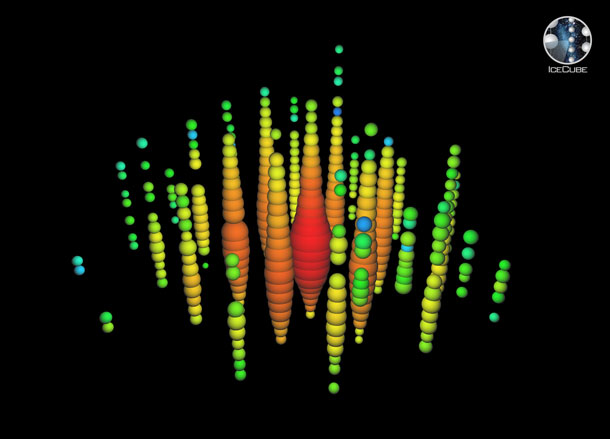
“Ernie”, the highest-energy neutrino observed to date, explodes inside IceCube. Since the entire detector is about a kilometer on a side, “Ernie” would have more than filled a professional football stadium. (Image: IceCube Collaboration)
It was a graduate student in Wisconsin who did that because you know they had some absurdly long number attached to them because each event has a number attached to it, and they just studied those things up the wazoo. You know, you had 200 physicists going crazy about what these things were. So, as with so many great things in science and in physics, they had been working for 14 years looking at the northern sky, and the first neutrinos that they detected from outer space snuck in from behind their telescope and came from the southern sky. And so then they totally reoriented themselves and started looking at these things and they've since found dozens and dozens more. And that was really the experiment that showed that they now can detect unequivocally neutrinos coming not from our atmosphere, which is kind of like the background light created by cities makes it hard to see stars, we have the same problem with neutrinos, but from the cosmos somewhere. And Aya says, you know, it was like the greatest experience of her life, this is what physicists and scientists live for, discovering new things looking at how the universe works, brings us out of ourselves and makes our minds bigger somehow. The thrill of the chase and then suddenly having the surprise which just blows your mind.
CURWOOD: Mark Bowen’s PhD is in physics, but he's now a writer and his new book is called, "The Telescope in the Ice: Inventing a New Astronomy at the South Pole." Mark, thanks so much for taking the time with us today.
BOWEN: Thank you, Steve, it's been a pleasure.
Links
The Telescope in the Ice: Inventing a New Astronomy at the South Pole
Mark Bowen’s blog “Tipping Points: Science and Writing in a Changing World”
Living on Earth wants to hear from you!
Living on Earth
62 Calef Highway, Suite 212
Lee, NH 03861
Telephone: 617-287-4121
E-mail: comments@loe.org
Newsletter [Click here]
Donate to Living on Earth!
Living on Earth is an independent media program and relies entirely on contributions from listeners and institutions supporting public service. Please donate now to preserve an independent environmental voice.
NewsletterLiving on Earth offers a weekly delivery of the show's rundown to your mailbox. Sign up for our newsletter today!
 Sailors For The Sea: Be the change you want to sea.
Sailors For The Sea: Be the change you want to sea.
 The Grantham Foundation for the Protection of the Environment: Committed to protecting and improving the health of the global environment.
The Grantham Foundation for the Protection of the Environment: Committed to protecting and improving the health of the global environment.
 Contribute to Living on Earth and receive, as our gift to you, an archival print of one of Mark Seth Lender's extraordinary wildlife photographs. Follow the link to see Mark's current collection of photographs.
Contribute to Living on Earth and receive, as our gift to you, an archival print of one of Mark Seth Lender's extraordinary wildlife photographs. Follow the link to see Mark's current collection of photographs.
 Buy a signed copy of Mark Seth Lender's book Smeagull the Seagull & support Living on Earth
Buy a signed copy of Mark Seth Lender's book Smeagull the Seagull & support Living on Earth

